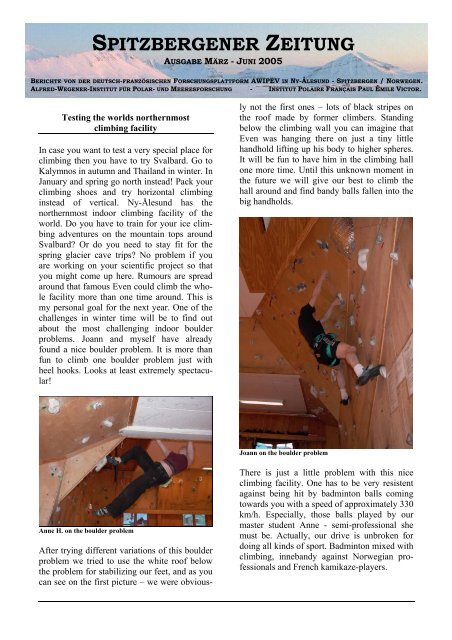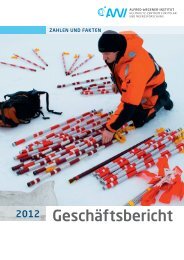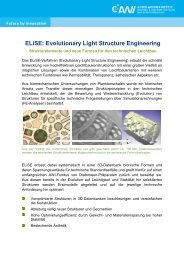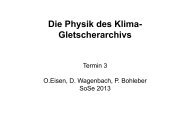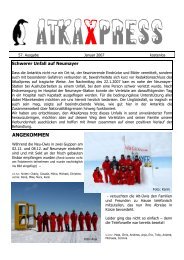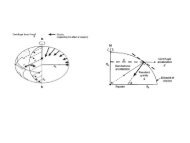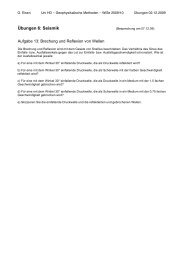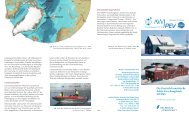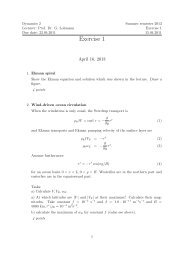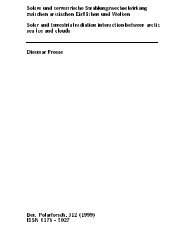SPITZBERGENER ZEITUNG - AWI
SPITZBERGENER ZEITUNG - AWI
SPITZBERGENER ZEITUNG - AWI
Sie wollen auch ein ePaper? Erhöhen Sie die Reichweite Ihrer Titel.
YUMPU macht aus Druck-PDFs automatisch weboptimierte ePaper, die Google liebt.
<strong>SPITZBERGENER</strong> <strong>ZEITUNG</strong><br />
AUSGABE MÄRZ - JUNI 2005<br />
BERICHTE VON DER DEUTSCH-FRANZÖSISCHEN FORSCHUNGSPLATTFORM <strong>AWI</strong>PEV IN NY-ÅLESUND - SPITZBERGEN / NORWEGEN.<br />
ALFRED-WEGENER-INSTITUT FÜR POLAR- UND MEERESFORSCHUNG - INSTITUT POLAIRE FRANÇAIS PAUL ÉMILE VICTOR.<br />
Testing the worlds northernmost<br />
climbing facility<br />
In case you want to test a very special place for<br />
climbing then you have to try Svalbard. Go to<br />
Kalymnos in autumn and Thailand in winter. In<br />
January and spring go north instead! Pack your<br />
climbing shoes and try horizontal climbing<br />
instead of vertical. Ny-Ålesund has the<br />
northernmost indoor climbing facility of the<br />
world. Do you have to train for your ice climbing<br />
adventures on the mountain tops around<br />
Svalbard? Or do you need to stay fit for the<br />
spring glacier cave trips? No problem if you<br />
are working on your scientific project so that<br />
you might come up here. Rumours are spread<br />
around that famous Even could climb the whole<br />
facility more than one time around. This is<br />
my personal goal for the next year. One of the<br />
challenges in winter time will be to find out<br />
about the most challenging indoor boulder<br />
problems. Joann and myself have already<br />
found a nice boulder problem. It is more than<br />
fun to climb one boulder problem just with<br />
heel hooks. Looks at least extremely spectacular!<br />
After trying different variations of this boulder<br />
problem we tried to use the white roof below<br />
the problem for stabilizing our feet, and as you<br />
can see on the first picture – we were obviously<br />
not the first ones – lots of black stripes on<br />
the roof made by former climbers. Standing<br />
below the climbing wall you can imagine that<br />
Even was hanging there on just a tiny little<br />
handhold lifting up his body to higher spheres.<br />
It will be fun to have him in the climbing hall<br />
one more time. Until this unknown moment in<br />
the future we will give our best to climb the<br />
hall around and find bandy balls fallen into the<br />
big handholds.<br />
Joann on the boulder problem<br />
Anne H. on the boulder problem<br />
There is just a little problem with this nice<br />
climbing facility. One has to be very resistent<br />
against being hit by badminton balls coming<br />
towards you with a speed of approximately 330<br />
km/h. Especially, those balls played by our<br />
master student Anne - semi-professional she<br />
must be. Actually, our drive is unbroken for<br />
doing all kinds of sport. Badminton mixed with<br />
climbing, innebandy against Norwegian professionals<br />
and French kamikaze-players.
<strong>SPITZBERGENER</strong> <strong>ZEITUNG</strong> - 2 - MÄRZ - JUNI 2005<br />
It was a wonderful morning with snowstorm<br />
and lots of work to do before the expected divers<br />
had to be picked up at the airport. In the<br />
middle of business Jens Kube, now at the Public<br />
Relation of <strong>AWI</strong> Bremerhaven and former<br />
station leader, called us at the Blue House.<br />
„Supergau“, he told us. “During Eastern all<br />
people of the Public Relations had vacations<br />
and they just had recognised an e-mail that was<br />
lost on the PC of one of the employers. The<br />
presidents of the German, Norwegian and<br />
French environmental governmental agencies<br />
will come with the helicopter on exactly that<br />
day. You need to give them a station presentation<br />
and after lunch they will take off already<br />
and leave Ny-Ålesund.” Ooops, I thought. I<br />
had a short talk with Thorsten and then he<br />
mumbled a little bit „just go to the NDSC building<br />
and start to build up the beamer with Joann,<br />
I will call Anita in order to hear about<br />
when the helicopter is to be expected on the<br />
airfield“. Though, I thought he reacts a little bit<br />
too calm, I just went over to Joann. He was<br />
sitting at his computer with Anne Theuerkauf,<br />
preparing an own supergau e-mail for the Lidar<br />
scientists. They were just writing something<br />
about an ozone sonde that had been fallen into<br />
the Lidar and destroyed some instruments during<br />
the last night – with some impressive pictures<br />
in attachment. Joann just smiled to me<br />
„are you sure that the president of the environmental<br />
something is landing with the helicopter?<br />
Or maybe today it is the 1st of April?“<br />
There it hit me. Jens - grumble – it seemed to<br />
me that he was not especially busy at Public<br />
Relations...<br />
Anne T. in Badminton action<br />
And the next time we will write about our mixed<br />
French-German party after battling the<br />
Norwegians totally unexpected.<br />
Anne Hormes<br />
How to handle a supergau…<br />
Visit of the Norwegian environmental ministry (EGON)<br />
welcomed by the station personnel<br />
We thought over it a little bit and decided that<br />
it was time for our own 1st of April joke. Egon<br />
took over the role of the minister and we took a<br />
fake picture in front of the Sysselman helicopter.<br />
Anne Hormes<br />
Balloon house party after<br />
digging snow<br />
Also this year it was time on the 14th of april<br />
to party for the change of the station leader.<br />
First, for this event the wheel loader had to<br />
come in order to blow all the snow away in<br />
front of the observatory. However, the purpose<br />
was not only to make people more comfortable.
<strong>SPITZBERGENER</strong> <strong>ZEITUNG</strong> - 3 - MÄRZ - JUNI 2005<br />
than me. How should I just have a slight chance<br />
to dig me through a kilometre long pile of<br />
snow when he just can use the spade and I already<br />
had to crawl into the tunnel to reach the<br />
end? In the end Thorsten and me were<br />
struggling through the snow to run as fast to<br />
the symbolic key as we could. I was just lucky<br />
to reach it milliseconds before him… Thank<br />
you Thorsten!<br />
Snow flurries in front of the NDSC (Joann<br />
Schmid)<br />
But we come to this point later. We started<br />
with a warm up and had some nice drinks outside<br />
on the terrace of the balloon house. Thorsten<br />
ordered excellent weather for this event.<br />
Like every year the handing over of the station<br />
from the former station leader to the new one is<br />
not an easy task. It is not just about signing<br />
several papers, which for example indicate<br />
how much ammunition is present at the station.<br />
It is much more. The scientific team of this<br />
year plus Roland Neuber, the scientific manager<br />
of Koldewey, the former and present station<br />
engineers Konnie Piel and Joann Schmid<br />
made the former and new station leader to do a<br />
competition first, before the symbolic key was<br />
handed over from Thorsten Wilhelm to Anne<br />
Hormes. A big snow pile had been prepared<br />
with the wheelloader in front of the NDSC<br />
observatory. Thorsten and me had to dig us<br />
through and get the big blue wooden station<br />
key on the other side of the snow pile.<br />
Los geht’s (Joann Schmid)<br />
I still have the feeling that it was kind of unfair<br />
to dig with the same length of spade then<br />
Thorsten. He is approximately 2 meters longer<br />
Thorsten digged much faster through the snow<br />
(Joann Schmid)<br />
Anne Hormes<br />
Landung in der Heimat<br />
Hallo zusammen! So, mittlerweile sind meine<br />
Tage auf Koldewey ja nun doch unwiederbringlich<br />
zu Ende gegangen. Nachdem die<br />
Zeit, in der das Licht langsam zurück kam,<br />
schon recht schnell verging, vergingen die Tage<br />
von der Stationsübergabe bis zu meinem<br />
Abflug ja noch schneller als geplant. Mittlerweile<br />
sitze ich nun wieder in unserer Forschungsstelle<br />
in Potsdam und bin an der Nachbereitung<br />
meiner 13-monatigen Überwinterung<br />
angelangt. Nachdem ich in Deutschland aufgeschlagen<br />
bin, musste ich mich tatsächlich erst<br />
etwas an die Reizüberflutung in der Großstadt<br />
gewöhnen, was sich aber ganz gut angelassen<br />
hat. Mein ganzes Gepäck, vier große Zarges-<br />
Aluminium-Kisten, sind auch wieder zu Hause<br />
angekommen und mussten ausgepackt werden,<br />
was so seine Zeit in Anspruch genommen hat.<br />
Was ist geblieben? Was nach knapp 400 Tagen<br />
auf Koldewey bleibt, ist ein überwältigender<br />
Eindruck von Spitzbergen, vom Land, vom<br />
Klima, von der Arktis, von den Menschen.
<strong>SPITZBERGENER</strong> <strong>ZEITUNG</strong> - 4 - MÄRZ - JUNI 2005<br />
3801 Manntage von gut 70 Stationsgästen waren<br />
abzuwickeln und zu betreuen, ein Drittel<br />
von Rabot, zwei Drittel Koldewey, von denen<br />
jeder durch seine Individualität faszinierte.<br />
Gleiches gilt für die dauerhaften Bewohner<br />
Ny-Ålesunds, mit denen man auf begrenztem<br />
Raum in engem Kontakt stand, ja stehen musste,<br />
um sowohl den Polartag zu er- und die Polarnacht<br />
zu überleben. Statistisch waren 36<br />
unterschiedliche Projekte zu betreuen, davon<br />
alleine 9 von der französischen Seite, fast e-<br />
benso viele Wetterballone wie Tage an der<br />
Station zu starten. VIPs und Besucher der unterschiedlichsten<br />
Nationen waren durch die<br />
Station zu führen, Rede und Antwort zu stehen,<br />
auch für zahlreiche Menschen von Presse,<br />
Rundfunk und Fernsehen. Messinstrumente<br />
waren zu betreuen und zu warten, gelegentlich<br />
Feldexkursionen per Scooter oder Boot zu einer<br />
der Außenstationen oder ins Gelände mit<br />
einigen Wissenschaftlern zu deren Unterstützung.<br />
So es denn mal ein freies Wochenende gab,<br />
war man bestrebt, sich von der Natur berauschen<br />
zu lassen, deren atemberaubenden Flair<br />
man sich nirgends entziehen konnte, wollte,<br />
oder erst recht deren Nähe suchte. Einige<br />
Holzhütten aus Bergbauzeiten boten immer<br />
wieder und gerne Unterkunft für einen ruhigen<br />
Abend in der Woche, oder auch ein ganzes<br />
Wochenende, alleine zu zweit, oder mit dem<br />
halben Dorf. Bullernde Kanonen- und Emailöfen<br />
wärmten mollig, in der Polarnacht warf<br />
der gelbe Schein alter Petroleumlampen aus<br />
der Gründerzeit seine breiten Schatten, heulender<br />
Wind an der Tür, ab und zu Spuren von<br />
Polarbären auf dem Weg zum Ziel oder nach<br />
Hause. Mitternachtssonne um drei, die einen<br />
nach dem Barabend um Stunden zurück warf,<br />
dafür Zeitung lesend im Freien bei Vollmond<br />
zur Mittagszeit im Winter, der Fjord dabei silbrig<br />
glänzend wie im Bilderbuch und wuselnde<br />
Polarfüchse zwischen den Füßen.<br />
Angenehm und psychisch überlebenswichtig<br />
die Kontakte zu Familie und Freunden unten<br />
im Süden, wenn auch spärlicher als sonst. Man<br />
möge mir dies verzeihen. Wichtig auch das ein<br />
oder andere Carepaket mit Beutelsuppen und<br />
selbstgebackenen Zimtwaffeln zur Weihnachtszeit,<br />
die Heimat rückt dann ein Stück<br />
näher. Erinnerungen an Norddeich Radio und<br />
die Grußsendungen in alle Welt, Koldewey im<br />
Funkloch, nur auf UKW werden zwei Sender<br />
aus Tromsø eingespeist, sonst auf allen Kanälen<br />
nur Rauschen im Äther.<br />
Doch all der Verzicht wird komprimiert durch<br />
die Großartigkeit der Natur und des Nordens<br />
an sich. Sind Kreuzfahrttouristen nach wenigen<br />
Tagen in den Fjorden schon hin und weg von<br />
diesem Land, dann bin ich es nach über einem<br />
Jahr erst recht.<br />
Aufgetürmt: Drei von vier leeren Kisten mit<br />
dem Ex-Stationsleiter. Berge von Wäsche türmten<br />
sich nach dem Leerräumen in der Wohnung<br />
- bleibt die Frage nach dem "Was zieh ich an":<br />
Tempex bei 30 Grad?? :-)<br />
Meine Lieblingskleidung auf Spitzbergen?<br />
Ganz eindeutig mein roter Tempex, von dem<br />
ich mich im späten Frühjahr nur schwer trennen<br />
konnte – Jens und Konni erinnern sich -<br />
und mein norwegischer Strickpulli natürlich.<br />
Und beim Essen: Egons selbstgebackene Kartoffelpuffer<br />
im Blauen Haus.<br />
Ja, diesmal als kleinen Rückblick auf ein Jahr<br />
Leben in der Arktis, man könnte ein ganzes<br />
Buch schreiben. Wie an dieser Stelle üblich, so<br />
möchte ich auch noch ein paar obligatorische<br />
Worte des Dankes loswerden, und zwar an die<br />
Leser der Spitzbergener Zeitung, deren Resonanz,<br />
besonders auf die Rätsel, immer große
<strong>SPITZBERGENER</strong> <strong>ZEITUNG</strong> - 5 - MÄRZ - JUNI 2005<br />
Freude gemacht und jedes Mal für willkommene<br />
Abwechslung gesorgt hat. So manch netter<br />
Kontakt kam zustande, so manch nettes Mail<br />
hat die Seiten gewechselt und besonders in der<br />
langen Dunkelheit des Winters für Kurzweil<br />
gesorgt. Besten Dank besonders an Karl Michael<br />
Müller, Anja Berger und Hilde Gertje.<br />
Außerdem ein riesiger Dank an meine Family<br />
und meine Freunde, allen voran meinen Eltern,<br />
sowie Marianne Helfrich, Marianne und Helmut<br />
Laun, Erika Reinhardt, Astrid Gruny,<br />
Frank Mayer, Hans Ulrich Wetterhahn, Konni<br />
Piel und Jens Kube für die Versorgung mit<br />
überlebenswichtigen Dingen des täglichen Bedarfs<br />
(ich denke hier speziell an die Beutelsuppen,<br />
Schokoladentafeln und oberhessischen<br />
Mettwürste ☺) und ganz besonders für die<br />
kommunikative Verbindung mit der Heimat.<br />
Die nächsten Ausgaben, wie auch schon diese,<br />
werden nun von meiner Nachfolgerin Anne<br />
Hormes erscheinen, und es wird bestimmt auch<br />
die eine oder andere Veränderung des Outfits<br />
geben. Ich bin gespannt darauf. Nun denn, auf<br />
ein Wiederlesen in der Spitzbergener Zeitung!<br />
Thorsten Wilhelm<br />
Froggies and birthday parties<br />
On the 7th of April Martin Mellet and Nicolas<br />
Le Viavant started to make Rabot comfortable<br />
and filled it with live. Martin is employed at<br />
IPEV since several years and has been already<br />
in Ny-Ålesund a couple of times. Nicolas has<br />
overwintered on Kerguelen island and just started<br />
to work for IPEV in January. They were<br />
mainly responsible to set up the Solar panels<br />
and local energy storage system at the clean air<br />
laboratory Corbel, 6 km outside Ny-Ålesund.<br />
Einstein läßt grüßen: Anne Theuerkauf und<br />
Thorsten nach der Rückkehr vor dem gleichnamigen<br />
Turm auf dem Telegraphenberg in<br />
Potsdam<br />
Des weiteren gebührt noch außerordentlicher<br />
Dank Siegrid Debatin und „Egon“ Jürgen<br />
Graeser, denn ohne ihre Mithilfe, teils rund um<br />
die Uhr und auch im Urlaub, sowie mit ihrer<br />
menschlichen Unterstützung würde die Station<br />
in ihrer derzeitigen Form und Qualität nicht<br />
bestehen.<br />
Solar Panels on Corbel clean air station outside<br />
Ny-Ålesund<br />
Their work started with a very sensible snowmobile<br />
drive out to Corbel with tons of batteries<br />
on the sledges. I guess that I had about 240<br />
kg on my sledge and it felt quite like we were<br />
driving with raw eggs and whiskey bottles packed<br />
on it. However, it worked out and we sa-
<strong>SPITZBERGENER</strong> <strong>ZEITUNG</strong> - 6 - MÄRZ - JUNI 2005<br />
fely could bring the batteries to the station. The<br />
next couple of weeks Martin and Nicolas went<br />
to Corbel at least twice a day to work on the<br />
energy setup and I was quite impressed how<br />
fast they were done with the whole thing.<br />
Christophe, Nico, Joann, Anne, Olivier and Xavier<br />
testing the outdoor coffee equipment<br />
One day in April Anne T. and me found out<br />
about that we have our birthday on the same<br />
day – maybe not exactly the same year, but…<br />
Therefore, we cooked some coffee on the terrace<br />
of the blue house and had a nice afternoon<br />
coffee break with Nico from IPEV and the<br />
CHIMERPOL team of the University of Grenoble,<br />
Christophe, Olivier and Xavier.<br />
Anne Hormes<br />
unvergesslich. Die weißen Berge verschmolzen<br />
mit den Wolken am Horizont und das ganze<br />
mit der tiefstehenden Sonne, das war dann<br />
schon fast wieder ein bisschen zu kitschig! Mit<br />
diesen „kitschigen“ Anblicken und Ausblicken<br />
sollte es auch in den nächsten drei Monaten<br />
nicht aufhören.<br />
Von Thorsten wurde ich dann in den Tagen<br />
nach meiner Ankunft in meine Hauptaufgabe<br />
der täglichen Sondierung eingearbeitet. Ich war<br />
noch in die letzten Züge der Match-Kampagne<br />
geraten und so waren Ozonsondierungen „auf<br />
Abruf“ an der Tagesordnung. Ein paar Mal<br />
hatten wir mit starkem Wind zu kämpfen und<br />
waren froh, wenn der Ballon keine Saltos vollführte<br />
und allzu schnell hinter dem Ballonhaus<br />
wieder herunterkam.<br />
Parallel dazu, wollten Egon und ich mit den<br />
Messungen für meine Diplomarbeit beginnen.<br />
In meiner Arbeit geht es um den Vergleich der<br />
gewonnenen Daten eines Fesselballonsystems<br />
mit dem arktischen Klimamodell HIRHAM.<br />
Es sollte die zeitliche Veränderung von Parametern,<br />
wie Temperatur, Windrichtung oder<br />
relative Feuchte der unteren Atmosphärenschicht<br />
(Grenzschicht) mit diesem Fesselballonsystem<br />
gemessen werden. Diese Daten sollen<br />
dann mit der Modellsimulation von<br />
HIRHAM für den gleichen Zeitraum verglichen<br />
werden.<br />
Fesselballon Experiment<br />
Longyearbyen Lufthavn, 23.02.05, 14Uhr<br />
nachmittags, ich war wirklich in Spitzbergen<br />
angekommen! Mein erster Gedanke als ich aus<br />
dem Flugzeug stieg: Hatte ich genug warme<br />
Sachen eingepackt? Für drei Monate sollte ich<br />
als Praktikantin in Ny-Ålesund arbeiten und<br />
auch Messungen für meine Diplomarbeit machen.<br />
Aber erstmal der Reihe nach…<br />
Angekommen in der letzten Februarwoche<br />
hatte ich noch das Glück die vorerst letzten<br />
Polarlichter für dieses Jahr zu sehen! Kurze<br />
Versuche diese auch zu fotografieren, gab ich<br />
schnell auf und entschied mich für die Variante<br />
des faszinierten Beobachtens.<br />
Besonders beeindruckend fand ich aber schon<br />
den Flug nach Ny-Ålesund. Über die riesige<br />
Schneewüste von Spitzbergen mit einem kleinen<br />
Flugzeug zu fliegen war wunderschön und<br />
Aufbau des Fesselballons mit Helium<br />
Dieses Fesselballonsystem basiert auf einem<br />
großen Zeppelin-förmigen roten Ballon (bei<br />
uns hatte er den Spitznamen „Schweinchen“)<br />
der mittels einer Schnur an einer am Boden<br />
befindenden Winde befestigt ist. Der Ballon<br />
hat eine spezielle Form, die ihn immer wieder<br />
in den Wind stellt und damit eine weitgehende
<strong>SPITZBERGENER</strong> <strong>ZEITUNG</strong> - 7 - MÄRZ - JUNI 2005<br />
konstante senkrechte Messposition ermöglicht.<br />
Mit der Winde kann man nun das „Schweinchen“<br />
hochlassen, je nach Schnurlänge bis in<br />
Höhen von maximal 3km. An diese Schnur<br />
werden Sonden in verschiedenen Abständen<br />
gehängt, die wie bei den normalen Radiosonden,<br />
Temperatur, relative Feuchte, Windrichtung<br />
und Windgeschwindigkeit, sowie den<br />
Druck messen. Dieses ganze System kann man<br />
nun über Stunden in der entsprechenden Höhe<br />
lassen und erhält alle 10 Sekunden Werte der<br />
Sonden.<br />
Soweit die Theorie…<br />
In der Praxis hatten wir das Problem das man<br />
dieses System nur bei Temperaturen von 0°C<br />
bis +50°C verwenden kann. Das haben wir sehr<br />
schnell herausgefunden, weil die Winde und<br />
auch teilweise die Sonden bei den weit unter<br />
0°C herrschenden Temperaturen Anfang März<br />
nicht funktionierten. Damit begann eine lange<br />
und verzwickte Geschichte, dieses System bei<br />
den Witterungsbedingungen zu dieser Jahreszeit<br />
in Spitzbergen zum Laufen zu bringen.<br />
Vor allem Egon investierte viel Zeit und Mühe,<br />
in endlosen e-Mail-Kontakten mit der Herstellungsfirma<br />
in Amerika Möglichkeiten für uns<br />
herauszufinden, wie wir die Probleme handhaben<br />
können.<br />
Zum Glück haben wir es aber geschafft das<br />
System den Witterungsbedingungen anzupassen<br />
um damit Aufstiege machen zu können. So<br />
konnten wir zum Beispiel einen „Traumaufstieg“<br />
machen in eine Höhe von 1500m und<br />
immerhin knapp 19h lang. Die anderen Aufstiege<br />
sind teilweise erheblich kürzer, da zum<br />
Beispiel auch der Flugverkehr beachtet werden<br />
musste. Die Piloten hätten nicht schlecht geschaut,<br />
wenn sie im Landeanflug auf NyÅlesund<br />
plötzlich einen großen roten Ballon vor<br />
sich gehabt hätten.<br />
Das Schweinchen über dem Scheteligfjellet<br />
Der Stationsingenieur zu Füssen der Stationspraktikantin<br />
Bei all dieser Arbeit blieb aber auch Zeit Ausflüge<br />
in die unheimliche faszinierende Landschaft<br />
um Ny-Ålesund zu machen. Ob mit dem<br />
Scooter oder mit dem Boot, es waren unheimlich<br />
schöne Eindrücke, Ausblicke und Momente,<br />
die ich so schnell nicht wieder vergessen<br />
werde. Das Leben in Ny-Ålesund ist wie eine<br />
Oase, die man mit einem weinenden und einem<br />
lachenden Auge wieder verlässt (Zitat Max).<br />
Fazit: Die ganzen drei Monate des Praktikums<br />
vergingen natürlich viel zu schnell und ich habe<br />
mir definitiv den Spitzbergen-Virus eingefangen!<br />
Ein dickes Dankeschön an alle, die mit mir<br />
dem Schweinchen geholfen haben (Egon, Joann,<br />
Anne, Thorsten und Uli) und mit denen<br />
ich eine wunderschöne und prägende Zeit in<br />
Ny-Ålesund verbringen konnte!<br />
Anne Theuerkauf<br />
Mercury Chemistry in Polar Region: an<br />
active work in Spitzberg<br />
Since 3 years now, a French group is coming<br />
every spring for understanding the fate of Mercury<br />
in the Arctic in the frame of the CHI-<br />
MERPOL program financed by IPEV. Mercury<br />
is a very toxic metal which can be strongly<br />
accumulated into the food chain. The entrance<br />
of that pollutant into the food chain is still a<br />
discussion. During spring, atmospheric mercury<br />
is chemically transformed into other chemical<br />
forms that can be more easily deposited<br />
onto snow surfaces. Since 2003, in collaborati-
<strong>SPITZBERGENER</strong> <strong>ZEITUNG</strong> - 8 - MÄRZ - JUNI 2005<br />
on with the Norwegian Institute for Air Research<br />
(N.I.L.U.) (i.e. Torunn Berg and Katrine<br />
Aspmo) we try to better understand these atmospheric<br />
transformations and that the deposition<br />
of toxic onto snow surfaces. Collection of<br />
snow samples allow us to understand how the<br />
snow pack is enriched with time.<br />
Pierre-Alexis Gauchard collecting snow using<br />
ultra-clean techniques in order to avoid any<br />
contamination during sampling (Christophe<br />
Ferari)<br />
The hut where during three years mercury in<br />
the air was measured (Christophe Ferrari)<br />
Christophe Ferrari, Olivier Magand, Xavier<br />
Fain and Pierre-Alexis Gauchard came to<br />
NyÅlesund in April-May 2005 to investigate<br />
the fate of atmospheric mercury during polar<br />
spring by measuring mercury in the atmosphere,<br />
mercury in surface snow samples and mercury<br />
re-emission fluxes form the snow to the<br />
atmosphere. After three years of study, it appears<br />
that the atmospheric spring depletion of<br />
mercury in the atmosphere could then be the<br />
result of local/regional chemistry around Svalbard<br />
but some of the depletions recorded can<br />
also be due to long range transport of air masses.<br />
Snow is not enriched in Mercury in the<br />
same way every year meaning that contamination<br />
can then be slightly different from one<br />
year to another.<br />
Snow pits dug on the Kongsvegn glacier in<br />
2003, 2004 and 2005 will allow us to reconstruct<br />
if mercury contamination is more<br />
higher during spring than during the rest of the<br />
year. Two more years of measurement will be<br />
done so as to have a better view of the possible<br />
contamination of Spitzberg by mercury.<br />
Christophe Ferrari - Olivier Magand - Pierre<br />
Alexis Gauchard - Xavier Faïn<br />
Laboratoire de Glaciologie et Géophysique de l'Environnement-<br />
38402 Saint Martin d'Hères cedex- Tel: +<br />
(33) 4 76 82 42 39 Fax: + (33) 4 76 82 42 01 e-mail:<br />
ferrari@lgge.obs.ujf-grenoble.fr<br />
Opening of the Arctic Marine Laboratory<br />
Kjell Magne Bondevik, the Norwegian Prime<br />
Minister, leant the diving knife from Kjersti<br />
Dale, the scientific adviser of KingsBay, in<br />
order to cut the algae in front of the Arctic Marine<br />
Laboratory. This was the final moment the<br />
whole village had been working to for months.<br />
The new Arctic Marine Laboratory (Kjersti<br />
Dale)<br />
The purpose of the Arctic Marine Laboratory is<br />
to offer scientists a modern facility for research<br />
in the fields of marine ecology, physiology,<br />
biochemistry, oceanography, marine geology<br />
and ice physics. 33 million Norwegian Kroner
<strong>SPITZBERGENER</strong> <strong>ZEITUNG</strong> - 9 - MÄRZ - JUNI 2005<br />
were invested by the Norwegian research department,<br />
trade ministry and the oil company<br />
Conoco Philips.<br />
Christine Steinhäuser in the new Laboratory<br />
(Jana Fredersdorf)<br />
The German research diving group of <strong>AWI</strong><br />
were the first ones to move into this top modern<br />
facility. And Lena Brey was the first<br />
scientist ever to work in the laboratories. Here,<br />
she can rely on running seawater and fresh<br />
water supplies that she can adjust to every<br />
temperature she needs for her experiments. In<br />
the old Nansen laboratories she had to fight<br />
several times with frozen seawater pipelines.<br />
The day after the opening an Arctic Science<br />
Seminar was held in the sportshall. Presentations<br />
about Climate Change in the Arctic were<br />
given by for example Dr. Rajendra Pachauri,<br />
director of the UN international climate panel.<br />
The best citation of the whole event was the<br />
one from Anne Berg, cook of KingsBay. She<br />
had prepared the barbecue in the evening with<br />
her collegues outside Mellageret and unfortunately<br />
it was snowing outside. A Norwegian<br />
journalist was wondering about that she was<br />
that weatherfast and she simply gave him a big<br />
smile and said:” If a barbecue is planned – there<br />
has to be a barbecue.”<br />
Anne Hormes<br />
Rätsel - riddle<br />
Welche durchführbaren Anreisemöglichkeiten<br />
gibt es an die Koldewey-Station?<br />
Which kind of travelling possibilities are feasible<br />
in order to go to the <strong>AWI</strong>PEV Arctic Research<br />
Base?<br />
Einsendungen per e-mail oder Schneckenpost<br />
mit der richtigen Lösung bitte bis 31. Juli an<br />
die SpitZe-Redaktion. Zu gewinnen gibt es drei<br />
Überraschungspakete.<br />
Please, send your answer to the research base<br />
until July-31 by e-mail or snail-mail. You<br />
might win one of 3 surprise packages.<br />
Address:<br />
N – 9173 Ny-Ålesund<br />
Spitzbergen – Norge<br />
e-mail: station@awi-koldewey.no<br />
Christian Wiencke had the pleasure to be one of<br />
the opening speakers<br />
Thank you to all photographers! All other pictures<br />
that are not mentioned with a name were<br />
done by Anne.
<strong>SPITZBERGENER</strong> <strong>ZEITUNG</strong> - 10 - MÄRZ - JUNI 2005<br />
At the base in March-June 2005<br />
Susanne Becker Sophie Bourgeon<br />
Lena Brey<br />
Claudia Daniel<br />
Christine Eschmann Xavier Fain<br />
Christophe Ferrari Jana Fredersdorf<br />
PierreAlexis Gauchard Dieter Hanelt<br />
Timo Kaminski Ulrich Kunz<br />
Ulrike Lüder Olivier Magand<br />
Thierry Raclot Daniel Remias<br />
Christoph Ritter<br />
Max Schwanitz<br />
Christine Steinhäuser<br />
Base Personnel:<br />
Anne Hormes<br />
Joann Schmid<br />
Martin Mellet<br />
Alain Pottier<br />
Anne Theuerkauf<br />
Betti Saier<br />
Katrin Streil<br />
Christian Wiencke<br />
Thorsten Wilhelm<br />
Raffael Maurer<br />
Roland Neuber<br />
Nicolas Le Viavant<br />
Franck Delbart<br />
Kuttefjella on Haakon VII Land northeast of Ny-Ålesund on the last scooter trip together with Trond<br />
Svenøe, Carl Petter Nielsen and Helge Digre, beginning of May<br />
Anne Hormes.


